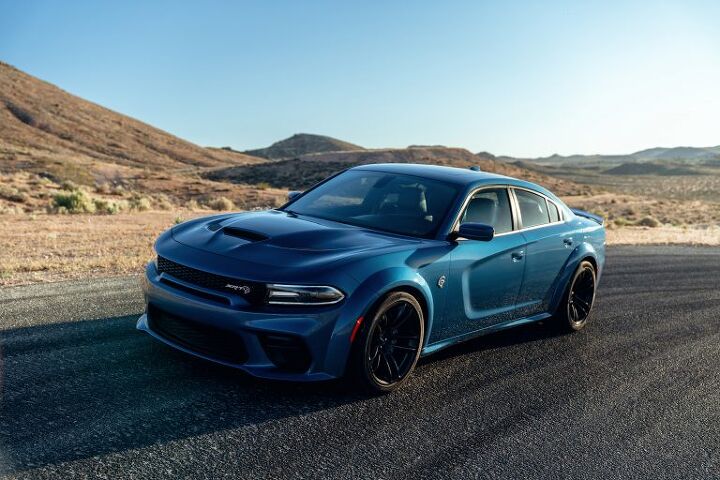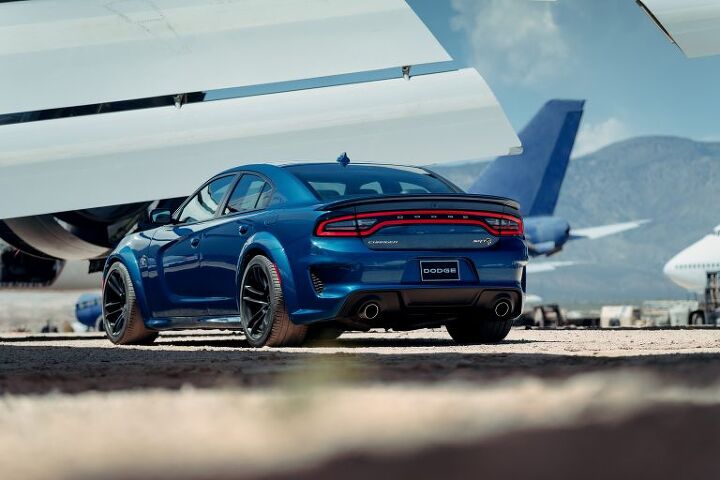Widebody Package Adds Maximum Muscle to 2020 Charger SRT Hellcat, Scat Pack
Maximizing the footprint with which to apply up to 707 horsepower and 650 ft-lbs of torque, the 2020 Charger SRT Hellcat and Scat Pack add a Widebody package to cover their 305/35ZR20 Pirelli tires and 20×11-inch wheels. For the Hellcat, 0-60 mph comes in 3.6 seconds while the quarter-mile elapsed time drops to 10.96 seconds and the skidpad grip builds to 0.96 g. Combined with the additional braking grip and revised chassis tuning, the lap time around an FCA-approved, 2.1-mile road course drops by a massive 2.1 seconds.
The Scat Pack Widebody sees similar improvements, getting to 60 mph from a standstill in 4.3 seconds on its way to a 12.4 second quarter mile. Without the weight of the supercharger and associated plumbing over the nose, the Scat Pack Widebody pulls an even more impressive 0.98 g on the skidpad. Around the same 2.1-mile road course (presumably GingerMan Raceway), the Charger Scat Pack drops 1.3 seconds in Widebody form.
The engines and transmission carry over from the narrow-body Charger models, but the additional grip of the 305-width tires aid in putting that power to the pavement. The 707hp 6.2-liter Hellcat V8 makes the headlines, but the 485hp from the 392-cubic-inch Hemi represents the most horsepower-per-dollar that you can buy in a sedan today.
All the upgrades in the Widebody package are built around the meaty Pirelli tires, starting with the integrated fender flares that add 3.5 inches of width to the body. Integrated with new front and rear facias, the stance gives the Charger inescapable presence. The only downside is a slightly reduced top speed of 196mph for the Hellcat Widebody, attributable to the increased drag from the larger frontal area and upsized tires.
Since the Widebody will be the only Charger Hellcat body style for 2020, it maintains its claim as the most powerful and fastest mass-produced sedan in the world.
Contained within the 20×11-inch wheels are the same 15.4-inch Brembo two-piece front brake rotors with six-piston front calipers and four-piston rear calipers found on narrow body models. With additional grip on hand, they bring the stopping distance down to 107 feet from 60mph. That’s down four feet from the skinny Hellcat and three feet for the Scat Pack.
To compliment the additional grip, chassis upgrades include stiffer springs and stabilizer (anti-roll) bars. The Hellcat Widebody receives increased front spring rates – 32 percent stiffer than previous model — and larger sway bars — expanding from 32 mm to 34 mm in front and from 19 mm to 22 mm in the rear. The Scat Pack Widebody receives 27 percent stiffer front springs and the same rear swaybar upgrade as the Hellcat. All extra-wide models come with Bilstein 3-mode adaptive damping, which has been calibrated to make the most of the newfound grip.
The Charger SRT Hellcat Widebody makes a move from hydraulic to electric power steering. Along with the standard SRT Drive Modes, all widebody models have user-selectable EPS settings relative to Street, Sport, or Track to go along with the suspension and powertrain preferences.
Having personally worked on the early stages of the vehicle dynamics tuning of the Scat Pack Widebody, the early setups showed a lot of promise in the car becoming a practical sedan that was genuinely at home on the racetrack. I’m looking forward to seeing how it turned out on the finished product.
[Images: FCA, Adam Tonge]
Following 10 years in Toyota's Production Engineering division, Anthony spent 3 years as a Vehicle Dynamics Engineer for FCA. From modest beginnings in autocross, he won a NASA SpecE30 National Championship and was the 2017 Pirelli World Challenge TC Rookie of the Year. Aside from being a professional racecar driver, he is a private driving coach and future karaoke champion.
More by Anthony Magagnoli
Latest Car Reviews
Read moreLatest Product Reviews
Read moreRecent Comments
- Turbo Is Black Magic My wife had one of these back in 06, did a ton of work to it… supercharger, full exhaust, full suspension.. it was a blast to drive even though it was still hilariously slow. Great for drive in nights, open the hatch fold the seats flat and just relax.Also this thing is a great example of how far we have come in crash safety even since just 2005… go look at these old crash tests now and I cringe at what a modern electric tank would do to this thing.
- MaintenanceCosts Whenever the topic of the xB comes up…Me: "The style is fun. The combination of the box shape and the aggressive detailing is very JDM."Wife: "Those are ghetto."Me: "They're smaller than a Corolla outside and have the space of a RAV4 inside."Wife: "Those are ghetto."Me: "They're kind of fun to drive with a stick."Wife: "Those are ghetto."It's one of a few cars (including its fellow box, the Ford Flex) on which we will just never see eye to eye.
- Oberkanone The alternative is a more expensive SUV. Yes, it will be missed.
- Ajla I did like this one.
- Zerofoo No, I won't miss this Chevrolet Malibu. It's a completely forgettable car. Who in their right mind would choose this over a V8 powered charger at the rental counter? Even the V6 charger is a far better drive.







































Comments
Join the conversation
While I prefer the "widebody" look of the old IMSA racers, these do just look right. The Scat Pack in that blue would be just the ticket.
Scat pack with the matted black hood takes away from the look of the Charger. If I buy this sedan, paint the hood the same color as the rest of the sedan!